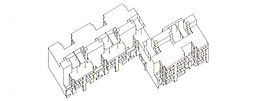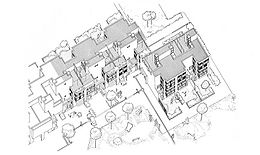
N. John Habraken
Encyclopedia
N. John Habraken is a Dutch
architect, educator, and theorist. His major contributions are in the field of mass housing and the integration of users and residents into the design process.

 Habraken studied architecture
Habraken studied architecture
at Delft Technical University, the Netherlands from 1948-1955. From 1965 to 1975, he was Director of SAR (Foundation for Architects Research) in the Netherlands, researching and developing methods for the design and construction of adaptable housing.
His seminal book 'Supports, an Alternative to Mass Housing'
was first published in 1962 (English edition 1972, re-issued in 1999). In the book, Habraken proposes the separation of 'support' or base building from 'infill' or interior fit-out in residential construction and design as a means of giving inhabitants a meaningful participative role in the design process. Habraken's theories have been linked to the Structuralism
movement in architecture.
In 1960, Habraken designed the WOBO (World Bottle) for Alfred Heineken
. The WOBO is a stackable beer bottle that can be used to build a bottle wall
. Initially developed in response to the lack of affordable building materials and the inadequate living conditions that beset Curaçao
's lower class, the WOBO is a pioneering example of industrialized recycling and adaptive reuse of materials.
In 1967 Habraken was appointed professor at Eindhoven Technical University, and charged with the responsibility to set up its new Department of Architecture and serve as its first chairperson. From 1975 to 1981 Habraken served as Head of the Department of Architecture at the Massachusetts Institute of Technology (MIT), Cambridge, MA. He taught at MIT until his retirement as Professor Emeritus in 1989.
Habraken remains occupied with methods and theory of architectural and urban design. He has lectured on these topics worldwide and is the author of a vast number of books, research reports, and many articles.
Habraken is recipient of the 1988 Creative Achievement Award of the Association of Collegiate Schools in the US; the David Roëll prize 1979 of the Dutch Prince Bernhard Fund; The King Fahd award for design and research in Islamic Architecture, 1985–86; and the Oevre Award for 1996 of the National Foundation for Art, design, and Architecture (BKVB oevre prijs) in the Netherlands. He is honorary member of the Architectural Institute of Japan
, Knight of the Royal Order of the Dutch Lion 2003, and Recipient of the 2003 “Kubus Award for Advancing the Standing of Architecture”, by the BNA, Dutch Association of Architects.
His book, titled: "The Structure of the Ordinary", is an investigation of laws governing the built environment as revealed by patterns of transformation.
His most recent book: “Palladio’s Children” is an attempt to explain why architects do not know how to deal with everyday environment. Habraken lives in Apeldoorn, The Netherlands.
Thomsonplein (square), construction 1921-1922. Urban planning by Hendrik Berlage, architecture by Jan Duiker
. Conflict between cultural heritage (Berlage+Duiker) and participation.
Netherlands
The Netherlands is a constituent country of the Kingdom of the Netherlands, located mainly in North-West Europe and with several islands in the Caribbean. Mainland Netherlands borders the North Sea to the north and west, Belgium to the south, and Germany to the east, and shares maritime borders...
architect, educator, and theorist. His major contributions are in the field of mass housing and the integration of users and residents into the design process.
Biography


Architecture
Architecture is both the process and product of planning, designing and construction. Architectural works, in the material form of buildings, are often perceived as cultural and political symbols and as works of art...
at Delft Technical University, the Netherlands from 1948-1955. From 1965 to 1975, he was Director of SAR (Foundation for Architects Research) in the Netherlands, researching and developing methods for the design and construction of adaptable housing.
His seminal book 'Supports, an Alternative to Mass Housing'
was first published in 1962 (English edition 1972, re-issued in 1999). In the book, Habraken proposes the separation of 'support' or base building from 'infill' or interior fit-out in residential construction and design as a means of giving inhabitants a meaningful participative role in the design process. Habraken's theories have been linked to the Structuralism
Structuralism (architecture)
Structuralism as a movement in architecture and urban planning evolved around the middle of the 20th century. It was a reaction to CIAM-Functionalism , which had led to a lifeless expression of urban planning that ignored the identity of the inhabitants and urban forms.Two different manifestations...
movement in architecture.
In 1960, Habraken designed the WOBO (World Bottle) for Alfred Heineken
Heineken
Heineken is a Dutch beer which has been brewed by Heineken International since 1873. It is available in a 4.6% alcohol variety in countries such as Ireland. It is the flagship product of the Heineken company and is made of purified water, malted barley, hops, and yeast. In 1886 H...
. The WOBO is a stackable beer bottle that can be used to build a bottle wall
Bottle wall
A bottle wall is a wall made out of glass bottles and binding material.-Bottle Wall Construction:A building construction style which usually uses 1l glass bottles A bottle wall is a wall made out of glass bottles and binding material.-Bottle Wall Construction:A building construction style which...
. Initially developed in response to the lack of affordable building materials and the inadequate living conditions that beset Curaçao
Curaçao
Curaçao is an island in the southern Caribbean Sea, off the Venezuelan coast. The Country of Curaçao , which includes the main island plus the small, uninhabited island of Klein Curaçao , is a constituent country of the Kingdom of the Netherlands...
's lower class, the WOBO is a pioneering example of industrialized recycling and adaptive reuse of materials.
In 1967 Habraken was appointed professor at Eindhoven Technical University, and charged with the responsibility to set up its new Department of Architecture and serve as its first chairperson. From 1975 to 1981 Habraken served as Head of the Department of Architecture at the Massachusetts Institute of Technology (MIT), Cambridge, MA. He taught at MIT until his retirement as Professor Emeritus in 1989.
Habraken remains occupied with methods and theory of architectural and urban design. He has lectured on these topics worldwide and is the author of a vast number of books, research reports, and many articles.
Habraken is recipient of the 1988 Creative Achievement Award of the Association of Collegiate Schools in the US; the David Roëll prize 1979 of the Dutch Prince Bernhard Fund; The King Fahd award for design and research in Islamic Architecture, 1985–86; and the Oevre Award for 1996 of the National Foundation for Art, design, and Architecture (BKVB oevre prijs) in the Netherlands. He is honorary member of the Architectural Institute of Japan
Architectural Institute of Japan
The Architectural Institute of Japan, or AIJ, is a Japanese professional body for architects, building engineers, and researchers in architecture....
, Knight of the Royal Order of the Dutch Lion 2003, and Recipient of the 2003 “Kubus Award for Advancing the Standing of Architecture”, by the BNA, Dutch Association of Architects.
His book, titled: "The Structure of the Ordinary", is an investigation of laws governing the built environment as revealed by patterns of transformation.
His most recent book: “Palladio’s Children” is an attempt to explain why architects do not know how to deal with everyday environment. Habraken lives in Apeldoorn, The Netherlands.
Publications
- Soportes: Vivienda y Ciudad / Supports: Housing and City, N. John Habraken & Andrés Mignucci, Essays on Supports, Thematic Design and architectural education as part of the Laboratorio de Vivienda del Siglo XXI at the ETSAB School of Architecture in Barcelona. Introduction by Josep María Montaner and Zaida Muxi, Universitat Politécnica de Catalunya, Barcelona, 2009.
- Palladio’s Children, Seven essays on the everyday environment and the architect. Edited by Jonathan Teicher, Taylor and Francis, London, New York, 2005.
- Die Träger und die Menschen, Das Ende des Massenwohnungsbaus, Arch-Edition, Den Haag, 2001, by Arnulf Lüchinger, ISBN 3-9522023-1-2 German translation of the Dutch "De Dragers en de Mensen, Het Einde van de Massa Woningbouw".
- Supports: an Alternative to Mass Housing, U.K., Urban International Press, Edited by Jonathan Teicher. Reprint of the 1972 English edition.
- The Structure of the Ordinary, Cambridge, London, MIT Press, 1998
- The Appearance of the Form, Cambridge, Awater Press,1985. Private edition. Second ed. 1988.
- Transformations of the Site, Cambridge, Awater Press, 1983. Private edition. Second ed. 1988.
- The Grunsfeld Variations: A demonstration project on the coordination of a design team in urban design. N. John Habraken with J.A. Aldrete-Haas, R. Chow, T. Hille, P. Krugmeier, M. Lampkin, A. Mallows, A Mignucci, Y. Takase, K. Weller, T. Yokouchi. Cambridge, MIT Laboratory for Architecture and Planning, 1981.
- General Principles about the Way Built Evironments Exist, Open House BCB series, SAR, Eindhoven, 1979.
- Variations, the Systematic Design of Supports, With J.T.Boekholt, A.P.Thyssen, P.J.M. Dinjens: MIT Laboratory for Architecture and Planning; distributed by MIT Press, Cambridge, USA and London 1976. English translation by W.Wiewel and Sue Gibbons from the original Dutch publication: Denken in Varianten,. Alphen a/d Rijn, Samson, 1974.
- Supports: an Alternative to Mass Housing. London: The Architectural Press, and New York: Praeger, 1972. First English-language edition. Originally published in Dutch under the title: De Dragers en de Mensen. Amsterdam: Scheltema en Holkema, 1962.
- Three R's for Housing, Amsterdam, Scheltema & Holkema, 1970; originally published in Forum, vol. XX, no 1, 1966.
- De Dragers en de Mensen, Het einde van de massa Woningbouw., Scheltema & Holkema N.V. Amsterdam, 1961
Cultural Heritage and Participation?
The HagueThe Hague
The Hague is the capital city of the province of South Holland in the Netherlands. With a population of 500,000 inhabitants , it is the third largest city of the Netherlands, after Amsterdam and Rotterdam...
Thomsonplein (square), construction 1921-1922. Urban planning by Hendrik Berlage, architecture by Jan Duiker
Jan Duiker
Jan Duiker was a Dutch architect. Partnership with Bernard Bijvoet from 1919 until 1925. For the commission of the Zonnestraal project the architects were recommended by Hendrik Berlage. Bijvoet left the Netherlands in 1925 to work in Paris with Pierre Chareau for projects such as Maison de Verre...
. Conflict between cultural heritage (Berlage+Duiker) and participation.

